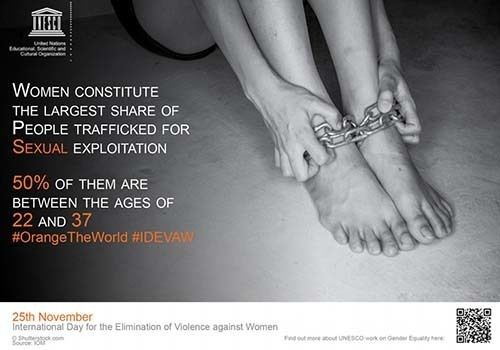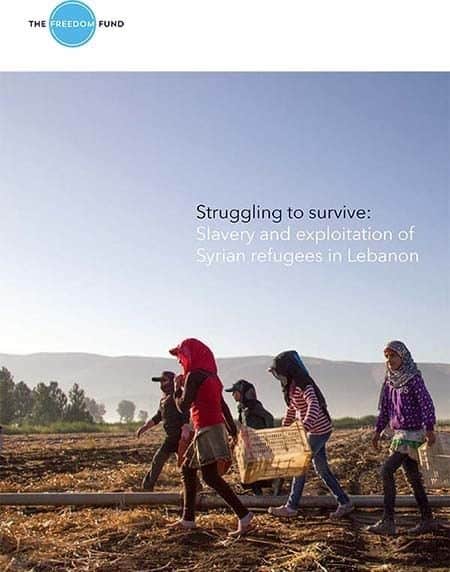Media and Human Trafficking, Slavery: The Guidelines
At the 2017 Arab Reporters for Investigative Journalism conference in Jordan, the Ethical Journalism Network hosted a workshop on human trafficking reporting in partnership with the International Centre for Migration Policy Development (ICMPD). EJN adviser, Magda Abu Fadil, took part in the event and wrote this blog.
Magda Abu Fadil
Is there a right way to cover human trafficking and slavery? Are there ethical pitfalls going undercover to produce an earth-shattering investigative report on this repulsive trade that can jar the world’s conscience?
It’s a topic that’s existed since time immemorial but has become increasingly thorny given the media attention it’s received, often tied in with the international migrant and refugee crisis.
It’s also prompted concerned ethicists to come up with tips on how to cover it.
I was happy to pitch in with resources and took part in a soft launch of guidelines during a panel last week at the Arab Reporters for Investigative Journalism’s (ARIJ) annual conference at the Dead Sea in Jordan.
This is my presentation – translated from Arabic – at the event, drawn from the guidelines and other sources.

Screenshot of UNESCO poster marking International Day for the Elimination of Violence Against Women.
News of human trafficking is one of the biggest and most difficult challenges facing media. It’s also an important test for media ethics.
Some 40 million people worldwide live in one form of slavery or another. There are 150 million children exposed to child labor and 150 million migrant workers.
The figures, though not specified, include millions of victims of human trafficking and slavery.
The largest number is of women sold for sexual exploitation and prostitution.
This type of news requires attention and sensitivity, as the language, portrayal, and context used by journalists and media may cause damage, incite hatred, and reinforce stereotypes.
It may also result in ignorance and misunderstanding that would divert attention from the root causes and hamper the public debate we need to solve this crisis.
“Kafa” (Enough), a Lebanese NGO, launched a campaign called “El Hawa Ma Byin Shara”(Passion/Vagary Can’t be Bought) that included a video clip of a hooker, with several men zipping up their trousers, and a message stating that buying sex leads to merchandizing, exploiting, being violent towards, and financing trafficking/trading in, women.
The organization’s full name is “Enough Violence and Exploitation in Lebanon and the Middle East.”
You may have watched the report by CNN International’s Nima Elbagir on the slave trade in Libya and the stir it caused.
It’s an excellent example of investigative journalism.
In an article on her work and life, the Poynter Institute said that although she didn’t doubt the veracity of the video of the slave trade and human trafficking she got, CNN wanted to verify it first-hand.
It quoted Elbagir as saying that it was one time when being a female journalist was an advantage. “They are just not used to thinking of women as posing a threat.”
Lebanese journalist and documentary maker Diana Moukalled followed the story and tweeted:
“More pictures and exposés on the extent of slavery in Libya…Two weeks ago professional slavery was uncovered where African refugees were sold in a slave trade market…International reaction is dim, and Libya announced shy procedures (to counter it) while Arab societies are in a slumber regarding this horrifying truth.”
Moukalled had featured a tweet by Kenyan Senator Susan Kihika who’d posted pictures of enslaved Africans in Libya saying:
“Aghast at the slave trade on our African brothers in Libya in 2017! Where on earth is the AU, UN, EU? Where is the outrage #slaveryinlibya”.
Here are the photos. How would you publish them in the media?
There are five key journalism values presented by the Ethical Journalism Network: Accuracy, independence, impartiality, humanity and accountability.
With Lebanese media floundering in the muck of tumultuous local politics, facing regional security threats, and international troubles, it’s no wonder their coverage of migration, refugees, and human trafficking is chaotic and confused.
Despite the existence of glossaries from various international organizations and NGOs, and reports documenting the facts, Arab journalists still use inaccurate language without distinguishing one term from another.
But the guidelines will be available to all in English and Arabic and are a useful handbook for journalists to facilitate their work.

Understanding the basics involves: human trafficking, migrant smuggling, national referral mechanism, transnational referral mechanism, undocumented or irregular migrants, slavery or modern slavery, sex trafficking, forced marriage, domestic servitude, child labor, worst forms of child labor, child sex trafficking, forced labor, bonded labor and contract slavery.
Domestic servitude is widespread in the Arab world where foreign domestic workers are often barred from leaving their employers’ homes, paid a pittance (if anything), subjected to offenses and bodily harm, and have their passports confiscated.
“Kafa” and other organizations contribute to creating awareness and interaction with the media to ensure proper coverage.
Newsroom strategies for coverage of human trafficking must be based on context, compassion and professionalism.
Their elements are to: understand, examine, monitor, establish good working relations with groups seeking to combat trafficking, build internal capacity, contribute to improving data collection and information exchange on human trafficking, and, develop focused campaigns on trafficking and related issues to raise public awareness.
The guidelines project was funded by the European Union, implemented by an international consortium led by the International Centre for Migration Policy Development (ICMPD) and authored by the Ethical Journalism Network’s director Aidan White.
The guidelines were written in English and will be made available for download in several languages.
This article was originally published on Magda Abu-Fadil’s Huffington Post Blog. It has been republished with permission.
Main photo: Screen shot of “Kafa” campaign poster on prostitution and trafficking.